11 of the best cities to visit in Spain: Where to stay and what to do
Whether its a coastal break or exploring historical sites, these are the best cities to visit in Spain
Your support helps us to tell the story
From reproductive rights to climate change to Big Tech, The Independent is on the ground when the story is developing. Whether it's investigating the financials of Elon Musk's pro-Trump PAC or producing our latest documentary, 'The A Word', which shines a light on the American women fighting for reproductive rights, we know how important it is to parse out the facts from the messaging.
At such a critical moment in US history, we need reporters on the ground. Your donation allows us to keep sending journalists to speak to both sides of the story.
The Independent is trusted by Americans across the entire political spectrum. And unlike many other quality news outlets, we choose not to lock Americans out of our reporting and analysis with paywalls. We believe quality journalism should be available to everyone, paid for by those who can afford it.
Your support makes all the difference.Blessed with Iberian sunshine and surrounded by crystal-clear waters from three different seas, Spain has anchored itself as a European hotspot for glorious weather.
It therefore comes as no surprise that Brits desperately seeking some warmth in the holiday periods flock to Spain and its islands, with the country boasting a Mediterranean climate, countless wineries, tapas plates and plenty of siestas.
But while destinations like Barcelona and Mallorca have been welcoming large numbers of tourists for decades, many of the main cities remain underexplored by tourists. The country is blessed with many traditions, cultures, cuisines and historical landmarks, all dotted around Spain from the coast to the mountainous regions.
To help you decide on where to visit we’ve rounded up a list of the best cities to visit in Spain, along with a recommendation on where to stay.
Barcelona
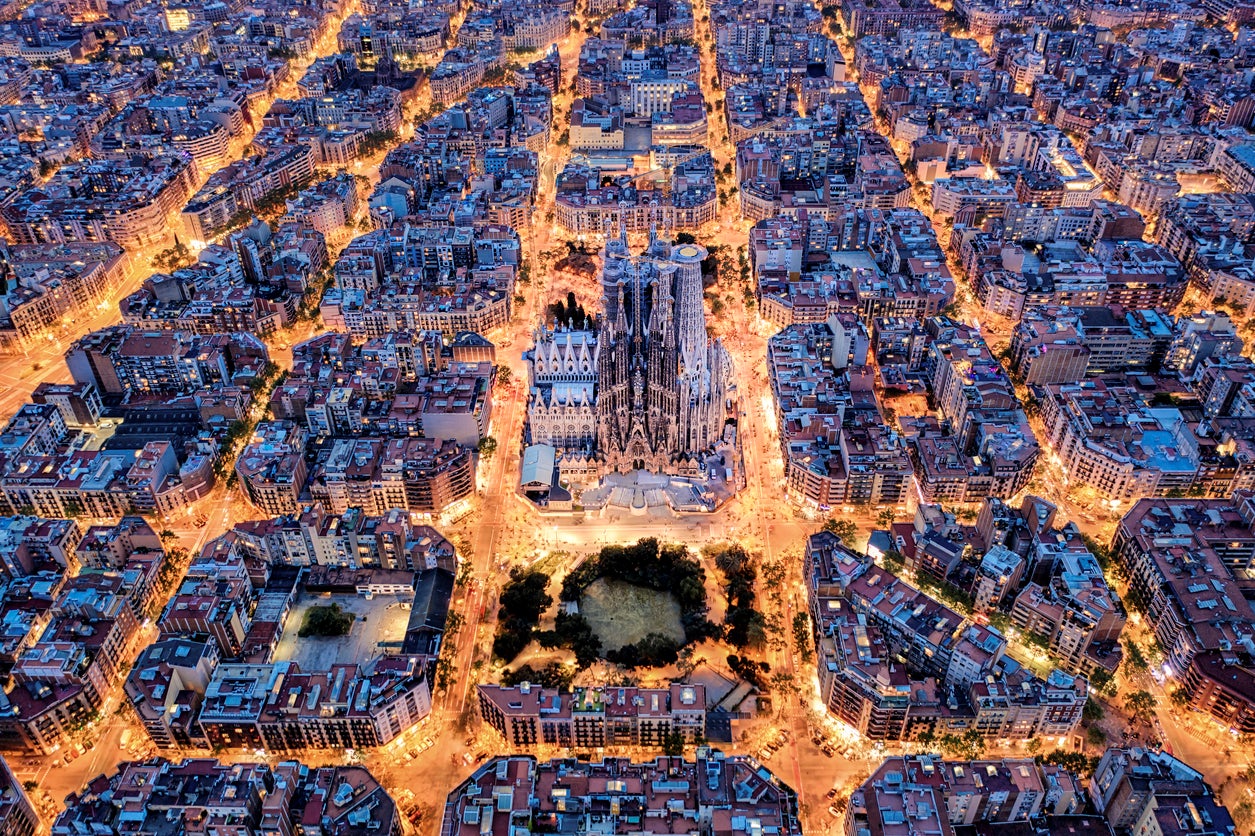
It will not take long to realise that Barcelona is a unique city in Spain, characterised as much by Catalan influences as it is by Spanish, and also by a desire to be different.
Nowhere is this more apparent than in the city’s architecture. The main landmarks, including the Sagrada Familia, Casa Batllo and Park Guell, are the work of one man, Antoni Gaudi, who championed the region’s own ‘Catalan modernisme’ style. The most popular districts, such as the Gothic Quarter and areas around the Old Town, are also drastically different to Madrid’s 17thcentury historic centre. While the presence of beaches is nothing unique for Spain, they have the added bonus of being unusually close to the city centre.
Catalan art is also more on the eccentric side, with the works of Dali and the city’s most famous adopted son, Pablo Picasso, proving that a forward-thinking attitude has existed in the city for centuries. See pieces from both at the Museu Nacional d’Art and the Picasso Museum. Unsurprisingly, the city’s main festivals are also a little unusual; visit in September for La Merce to see performances throughout the city and the region’s famous ‘construction’ of human towers.
Where to stay
The city is blessed with fantastic hotels, but the Iberostar Paseo de Gracia is perhaps the best for combining comfort and location. Situated at the end of the Paseo de Gracia – Barcelona’s answer to the Champs-Elysees – and just at the top of La Rambla, it is ideally placed for exploring the city on foot. It features modern, stylish rooms and a magnificent rooftop terrace with a pool, making for comfortable evenings and the opportunity to enjoy a cocktail with sweeping views over the city.
Read more: How to afford a family city break in one of Europe’s biggest tourism destinations
Valencia
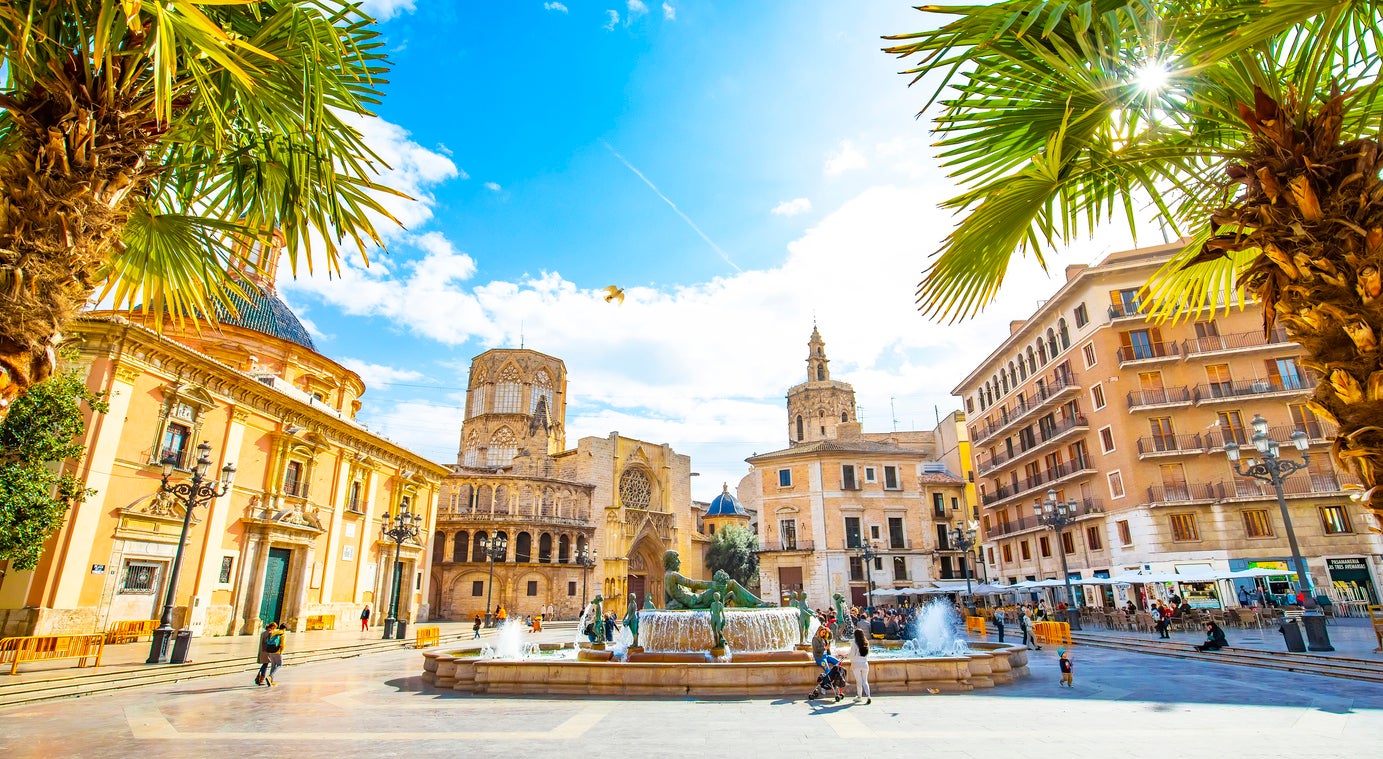
Valencia may feature less on the tourism radar – as it stands – than cities like Seville or Malaga, but this is unlikely to be the case for long. A city brimming with Spanish character, it is centred around its Old Town and three picturesque plazas, running from the vast Ayuntamiento Square to the charming Plaza de la Virgen, which borders the popular Carmen barrio.
Along with Ruzafa in the south, Carmen is one of the city’s nightlife centres and a popular place for locals to eat, drink and peruse various shops. Out of town, the El Cabanyal neighbourhood marks the beginning of Valencia’s beachfront, with the nearly two-mile walk up to Patacona showcasing the best of the city’s beaches and chiringuitos.
Though the ease with which you can walk through it is one of Valencia’s best characteristics, a cycle through the five-mile Turia Park is popular among visitors. The route ends at the City of Arts and Sciences, the modern-day symbol of the city that contains strikingly avant-garde buildings, large gardens and Europe’s largest aquarium.
Where to stay
Located in the centre of Valencia’s Old Town, the Vincci Palace balances luxury and accessibility, with an excellent location and affordable price point. Sitting within walking distance of almost all the city’s main sights, it contains classy interiors, with a blend of modern decor in the rooms and art deco touches in the bar and common areas.
Read more: How to be a good British tourist and why Valencia is welcoming us with open arms
Madrid
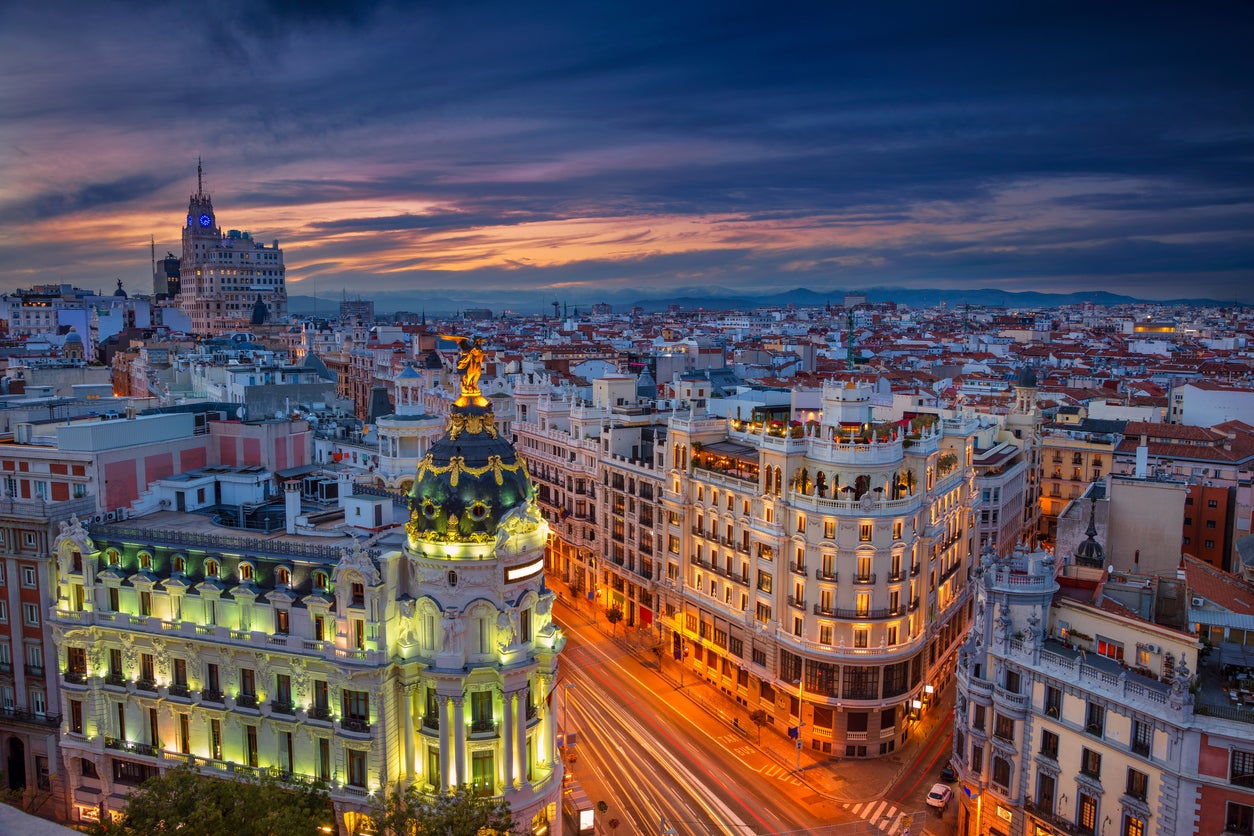
The Spanish capital may sometimes be overlooked by tourists flocking to Barcelona or Mallorca, but this is the place to go to experience authentic Spain, away from the influences of mass tourism. The city is home to several of Spain’s main cultural institutions, from the art of the Reina Sofia to a plethora of tapas bars.
The modern heart of the city is Gran Via, a mile-long avenue with impressive 20thcentury architecture and home to the city’s main shopping area. Close by lies the historic heart of Madrid, running from near the 16thcentury Plaza Mayor to the vast Royal Palace.
On the other side of the central area lies the sprawling Retiro Park, a popular hangout for locals and tourists alike and a gateway to the city’s famed ‘Golden Triangle’ of art museums, where aficionados can see works from Picasso, Goya and Velazquez at the Reina Sofia and El Prado. In between these areas lies ‘local’ Madrid, in the neighbourhoods of Malasana, Chueca and La Latina, where madrilenos gather for long lunches, evening drinks and tapas crawls.
Where to stay
Situated at the bottom of Gran Via, the Dear Hotel Madrid has an excellent location for first-time visitors and those looking to explore as much the city as possible. A hotel with delightfully simple, modern interiors and comfortable, spacious rooms, its affordability, exceptional breakfast options and rooftop pool set it apart from nearby competitors.
Read more: The hidden Spanish holiday hotspots where you can avoid crowds – and tourist trap prices
San Sebastian
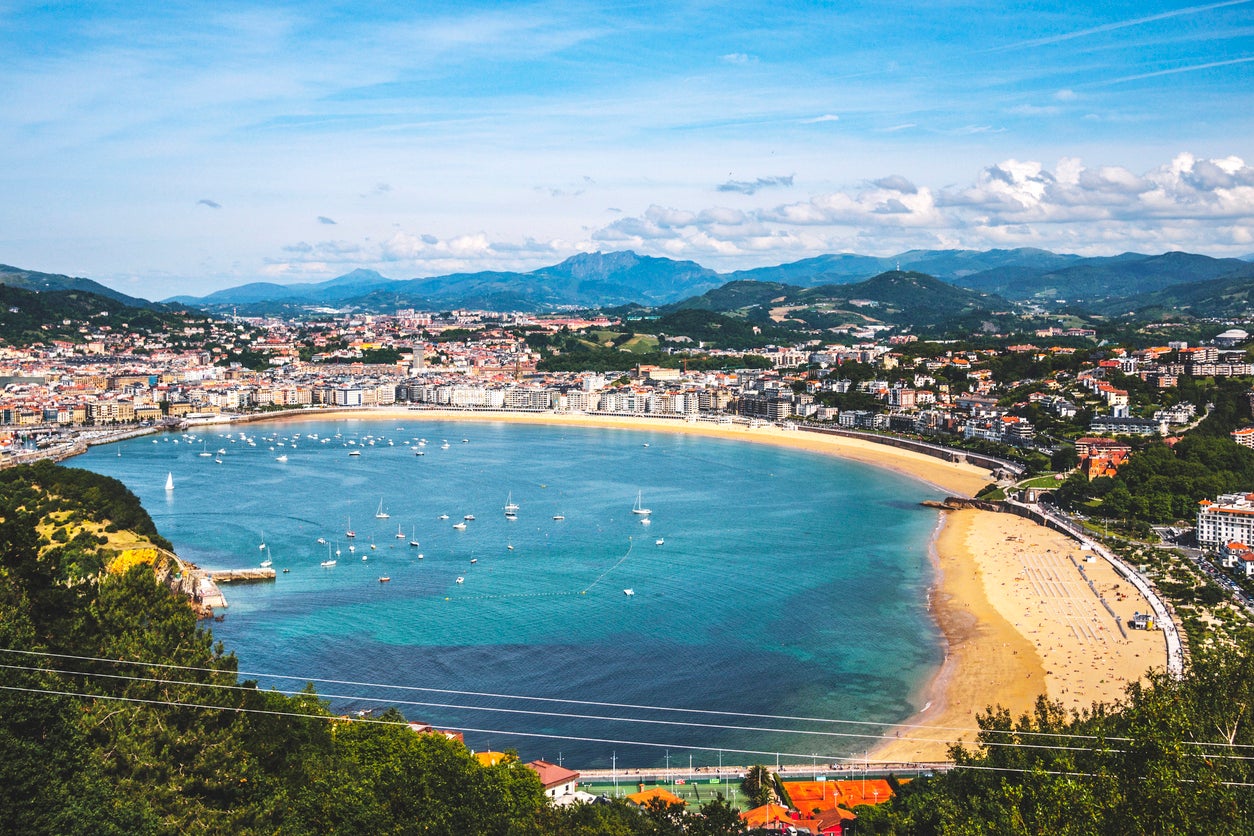
San Sebastian features many of the characteristics that have made Spain so popular with foreigners, but the addition of a now world-famous food scene and one of the country’s most famed beaches means that it is beginning to pop up on the radar of more and more tourists.
It is one of few cities that is seemingly built around its beach, spread across the waterfront of La Concha Bay and creeping back into the surrounding mountains in a sea of varied architecture, from Belle Epoque buildings to a Baroque basilica. The Old Town with its mazy streets is home to a variety of pintxo bars, which serve a popular Basque variation of tapas (the quality of which is exceptional across the board).
And while this affordable Spanish cuisine, found on almost every street corner, has undoubtedly contributed to the city’s burgeoning reputation as a foodie destination, the proliferation of Michelin stars is probably the city’s most noteworthy feature.
Where to stay
With an idyllic location on La Concha Bay, and a rooftop overlooking the golden sands and the azure waters of the Bay of Biscay, Lasala Plaza is the ideal place to stay for easy access to the Old Town and some of the best views over the city. Though housed in a magnificent 20th century building, its rooms and interiors are suitably modern, with muted tones and great views over the Old Town and the Bay.
Read more: San Sebastian city guide: Where to stay, eat, drink and shop in Spain’s gourmet hot spot
Seville
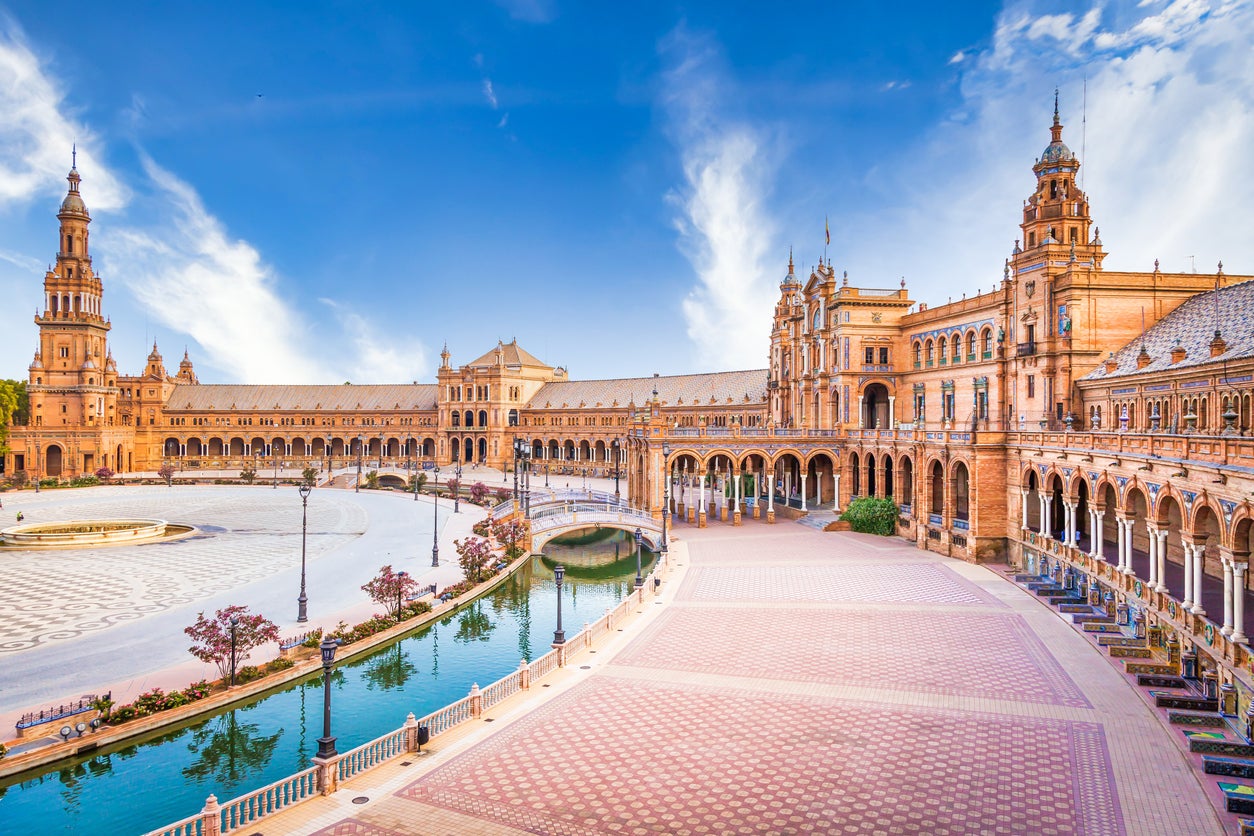
Supposedly the warmest city in continental Europe, Seville has long welcomed tourists looking for sun in the off-seasons and remains popular year-round as it caters for a broad range of holidaymakers, from culture vultures to partygoers. And despite having to remind tourists to behave appropriately, Seville couldn’t be further from a tacky, overrun destination for boozed-up Brits.
It is a city that manages to blend extensive Moorish influences with its role as a bastion for Spanish history and culture, boasting landmarks like the enchanting Alcazar palace, one of Spain’s largest still functioning bullrings or the city’s grandiose Cathedral and Giralda tower. The Old Town may be as busy as any in Spain, but it is for good reason; its cobbled streets are teeming with small squares and tasty tapas bars, with just a small walk taking you to plazas filled with locals out for an evening drink.
Venturing a little further out will take you either to the banks of the Guadalquivir River or to the Maria Luisa park, where the magnificent Plaza de Espana and parts of the 1929 Iberian-American Expo stand as stark reminders that this is, first and foremost, a city with tangible cultural heritage and some of the most beautiful architecture in the country.
Where to stay
Choose the H10 Casa de Plata for a relaxing stay in the centre of the city, just 10 minutes away from the Alcazar and other attractions. Like Seville, the hotel blends typically Spanish decorations – think courtyards and white-washed walls – with a small dose of Moorish flair, including ceramic tiles and water features. The recently added terrace and rooftop pool complete the hotel.
Read more: Why the Canary Islands should be your next holiday destination for winter sun
Malaga
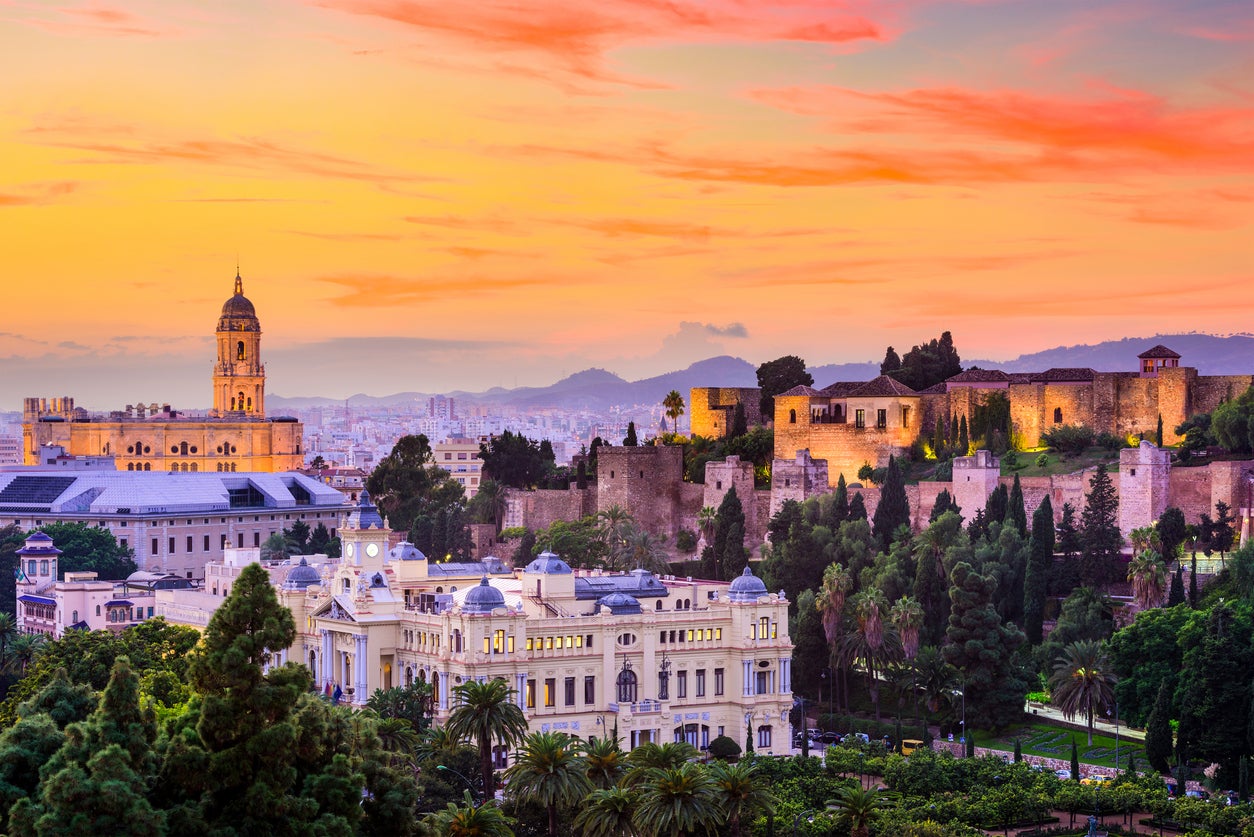
A seaside alternative to Seville, Malaga offers similarly impressive cultural sights along with long stretches of golden sand on beaches like Malagueta and Caleta.
The city’s main landmarks are the Alcazaba, a palatial complex that dates back to Moorish times, and the Gibralfaro Castle, both of which sit in the hills overlooking the city, offering panoramic views of Malaga alongside the opportunity to learn about its history.
In town, the city’s historic centre is a place to start exploring, with a mixture of wide boulevards and narrow streets containing churro shops, small cafes and a host of historic landmarks, including Picasso’s childhood home and a museum dedicated to him. Calle Larios is the centre’s beating heart, with the roads leading off it containing several historically important churches, palaces and convents.
Where to stay
The Only You hotel sits less than a mile from the Alcazaba, Gibralfaro Castle and the Cathedral, providing simple access to the beach and the city centre. Its eighth-floor roof terrace is a highlight, but a range of elegant modern rooms – some of which come with fantastic terraces of their own – means that you’ll be equally comfortable in your room as you are sipping a cocktail overlooking the coast.
Read more: The Canary Island you might not have thought of for wine – and running
Palma
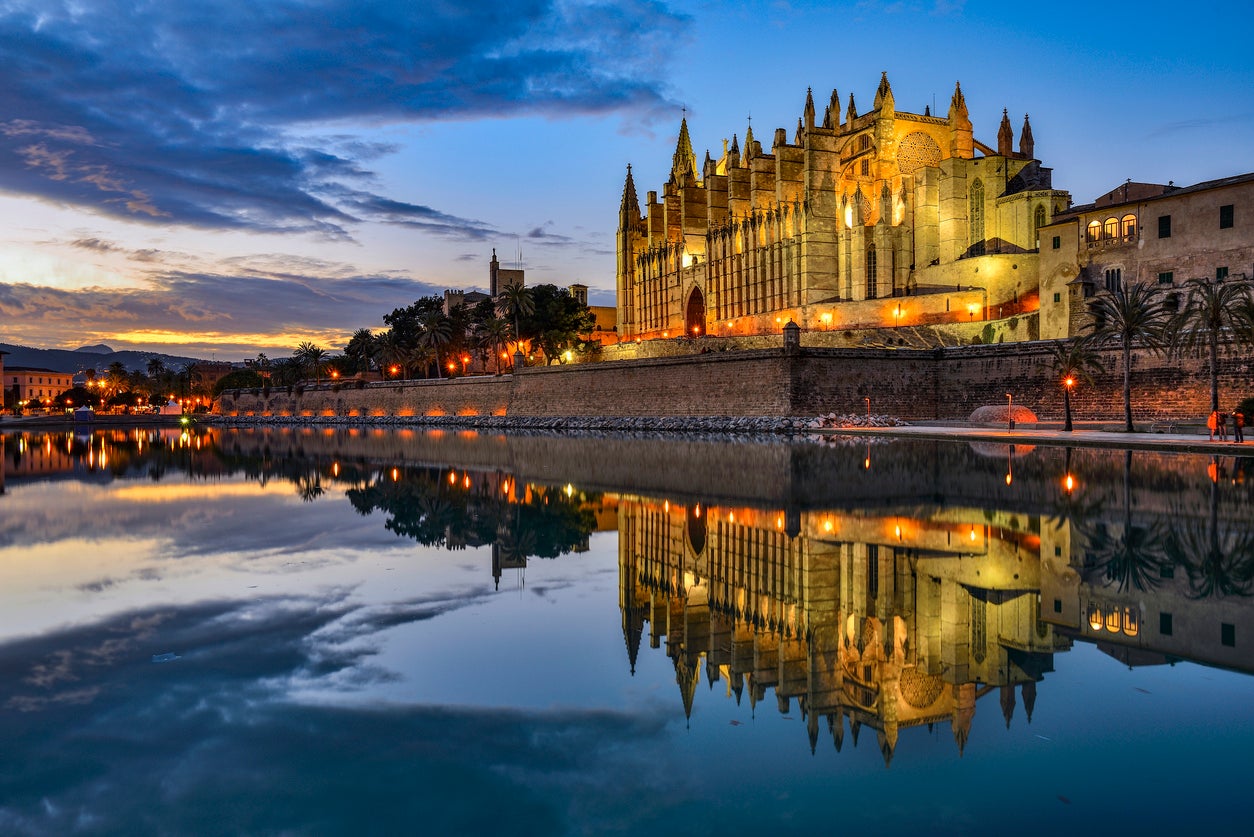
Perhaps Spain’s most famous island, Mallorca showcases Balearic beauty in abundance, and Palma provides the island’s heartbeat. It is home to a variety of Gothic and Art Nouveau architecture, the most impressive of which is the vast La Seu cathedral and the imposing Almudaina palace, with a charming pedestrianised historic centre providing even more character and plenty of bars and restaurants to sample in the evenings.
As well as walking across famous Old Town streets such as Calle Apuntadores, Via Veri and the Paseo del Borne, popular attractions include the Es Baluard Museum of Modern Art and the Miro Foundation, a sister exhibition to the artists’ museum in Barcelona. Food markets at Santa Catalina and Olivar are frequented by locals and tourists alike, while a walk along the marina at Paseo Maritimo is not to be missed either.
Another part of Palma’s allure is the ease with which you can take a day trip, with coastal areas and towns reachable within 30 minutes by car. Some of the most popular destinations include port towns like Pollenca and Andraxt, or beaches such as Cala Mayor, Palmanova and Cala Comtessa.
Where to stay
To experience the best of the city and the beaches, opt for the Portixol Hotel just west of the city centre. Reachable within around half an hour on foot from the Old Town, this beachfront paradise has a beach club-esque pool and terrace area, a gourmet restaurant and its own spa and wellness centre. Rooms have a loose maritime theme and come with balconies that offer great views of the harbour and mountains.
Zaragoza
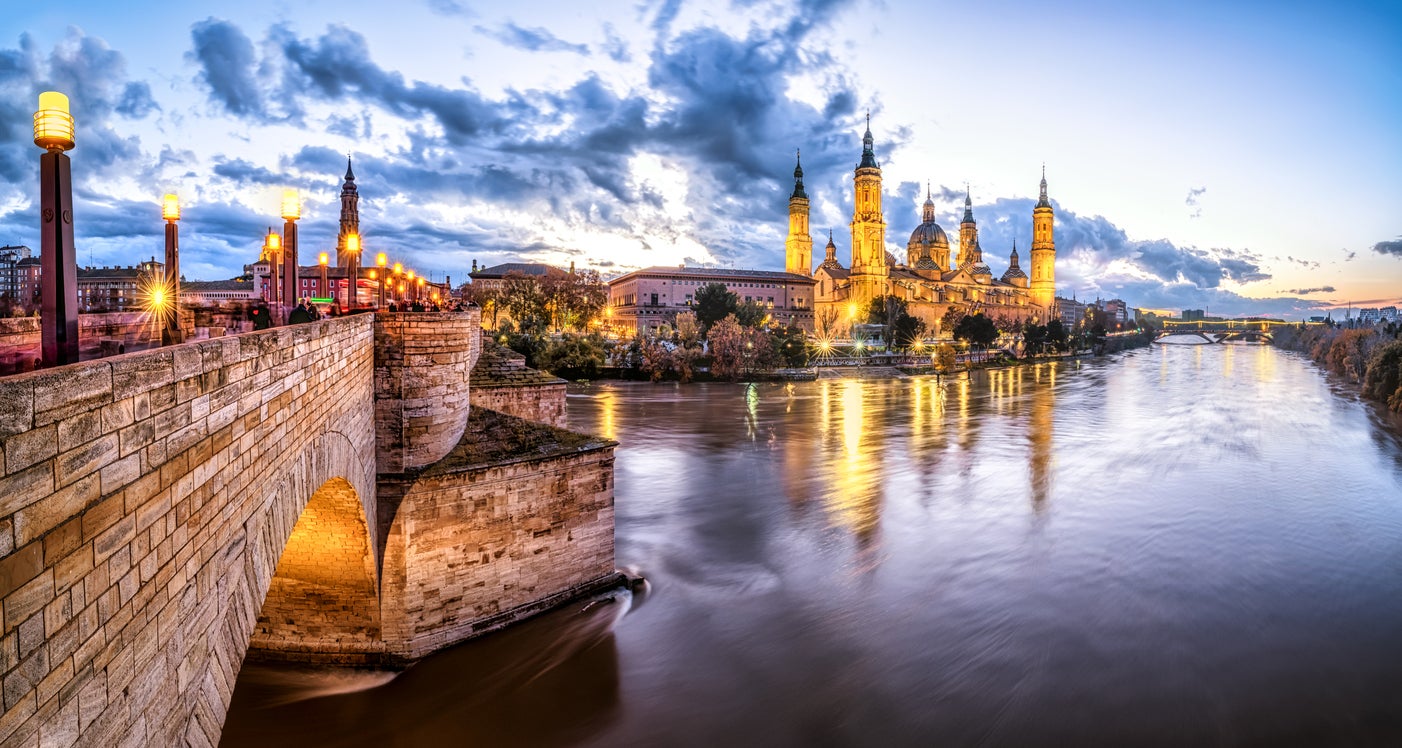
This northern city remains undiscovered by many who visit Spain, but it should be on the tourist must-see list whether you’re a veteran of the country or a first-time visitor. Sat on the banks of the Ebro River, it is as picturesque a city as any in the country, with photos of the Pilar Basilica – an important pilgrimage site for many Spaniards – an enduring image of the country and its often magnificent religious architecture.
Like many of its counterparts, Zaragoza is home to a labyrinthine Old Town that provides an insight into the city’s history at every turn. Start at the Zaragoza Museum in Plaza de los Sitios if you want to learn more, before getting lost in a maze of Mudejar architecture, Roman ruins – including the archaeological remains of the Museo del Foro de Caesaraugusta – and the customary tapas bars and watering holes (El Tubo is the place to go for the best eateries and most lively bars).
The city is known as the one-time home of Francisco Goya, one of the country’s most beloved artists, and many of his works, from etchings to frescoes, are scattered throughout the city, notably in the Museo Goya-Coleccion Ibercaja.
Where to stay
The NH Ciudad de Zaragoza is located close to the banks of the Ebro, less than 10 minutes from the Basilica, with many rooms overlooking these two defining points of the city. Interiors are muted and somewhat pared-back, but the spacious rooms and ideal location will give you a comfortable stay with easy access to the best parts of the city.
Read more: The best beaches in Tenerife
Bilbao
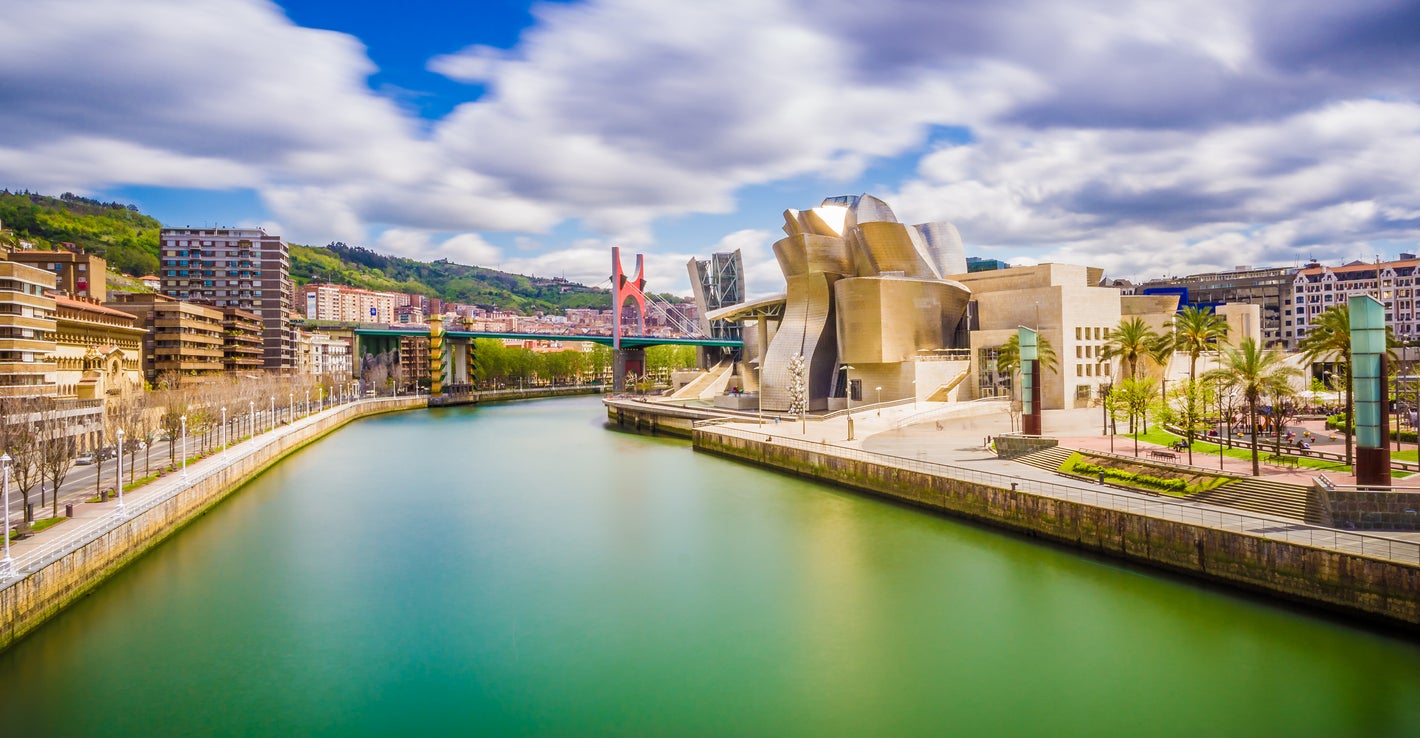
The Basque Country’s industrial port city may be a less glossy alternative to San Sebastian, but a culture perfectly preserved by a fiercely proud population makes this city as characterful as any in Spain. Although it still retains a sense of the industrial, the winding Nervion River and mountain backdrop give the cityscape some pizzazz, and in recent times the city has made a considerable investment in tourism too, with the notable addition of the Guggenheim Museum in 1997 suddenly putting it on tourism radar.
It doesn’t boast the beaches of neighbouring San Sebastian – the best are found away from the city in areas like Larrabasterra – but it shares some characteristics, most notably a penchant for pintxos and a slew of normal-looking restaurants that serve what will likely be the best meal you have this year (the stalls in the indoor Ribera market are a good place to start).
Where Bilbao does gain points over its rival, however, is within the atmospheric cobbled streets of its Old Town (Casco Viejo), one of the largest in Spain. Best experienced during the ‘Semana Grande’ celebrations in August, the heart of the area includes Bilbao’s original seven streets, which date back to the 1400s and today house countless bars and tapas taverns.
Where to stay
The Barcelo Bilbao Nervion lies just north of the Casco Viejo, sitting serenely on the banks of the Nervion and close to the Guggenheim. Rooms are smart and simple, with an on-site restaurant allowing you to sample some traditional Basque cuisine.
Read more: Spain’s warmest places for winter sun
Granada

Located at the foot of the Sierra Nevada mountains and between the rivers Darro and Genil, Granada and the surrounding region has so much to offer in terms of history, culture and breathtaking architecture. On the hills surrounding the city is the medieval part of Granada, areas of which are protected as a Unesco World Heritage Site. The uphill neighbourhood of Albaicín is rich in Moorish art, architecture and culture, scattered with winding alleys and staircases leading you up to a magnificent view of the Alhambra palace and fortress, one of the best-preserved examples of historic Islamic architecture built during the 13th and 14th centuries.
Aside from its historic wonders, Granada also has a lot to offer in terms of its dancing culture, with the Roma tradition of Zambra Flamenco honoured with performances in Sacromonte caves. The caves became housing for those marginalised in the city, more of which can be learned about at the Museo Cuevas del Sacromonte, which showcases eleven caves and what it would have been like to live in them. Today, traditional flamenco dances are performed in the neighbourhood, offering an experience in expression and cultural celebration.
Where to stay
The five-star boutique hotel Palacio Gran Vía is in the centre of Granada, housed in a former bank, emulating luxury and opulence as much as its disused bank vaults once did. Guests can choose from deluxe rooms or can reserve the Royal Suite on the highest floor, complete with a terrace and unbeatable views of the city. The hotel also provides a wellness spa and an intimate rooftop bar.
Read more: This city is like no other in Spain – here’s why it’s such an amazing place to visit during Ramadan
Ibiza Town

When Ibiza springs to mind, flashes of late-night partying, giant hangovers and gussying up before hitting the dancefloor may be what pops up in thought, yet Ibiza’s port city has plenty to offer outside of dancing away until the AM, from the ancient burial site of Necròpolis del Puig des Molins to kayaking, windsurfing and diving.
The old town of Dalt Vila, with its old fortified defensive walls embracing the medieval settlement, overlooks sublime coastal views of the Mediterranean. For relaxing in the sun, many visitors set up camp for the day at Figueretas, a sandy stretch lined by a palm-fringed promenade in the suburbs of the city. For those looking for a spot of shopping, or a place to mull over the events of the night before with friends, head to Vara Del Rey, an avenue in the heart of the city with colonial-era style architecture up and down the street.
Not forgetting the party people who flock to Ibiza every summer, those who are staying in Ibiza Town might check out the world-famous Pacha Ibiza nightclub that attracts some of the largest DJ names in dance music. Carrer de la Verge is another favourite, a lane that serves as Ibiza’s primary LGBT+ village with around 20 bars to be enjoyed.
Where to stay
For those looking to experience Ibiza seated at an exquisite cocktail bar rather than dancing in a nightclub, Montesol Experimental offers luxury stays in one of their 33 bedrooms. The rooms were created by award-winning hotel designer Dorothée Meilichzon, filled with cool, calming colours and inspiration from bohemian Ibiza. Dine on tapas on the hotel’s terrace or drink your favourite tipple as the sun sets over the rooftop cocktail bar.
Read more: Spain travel guide

Join our commenting forum
Join thought-provoking conversations, follow other Independent readers and see their replies
Comments